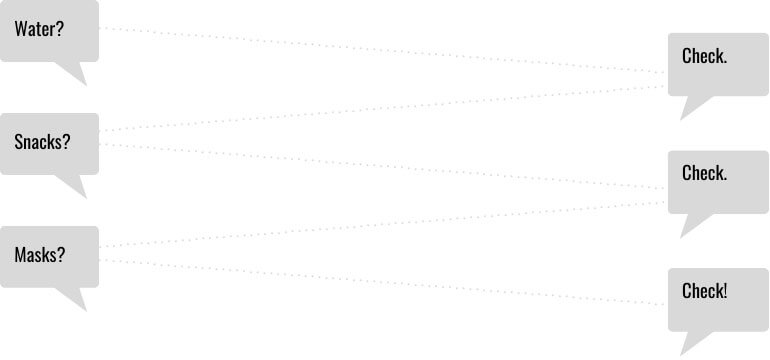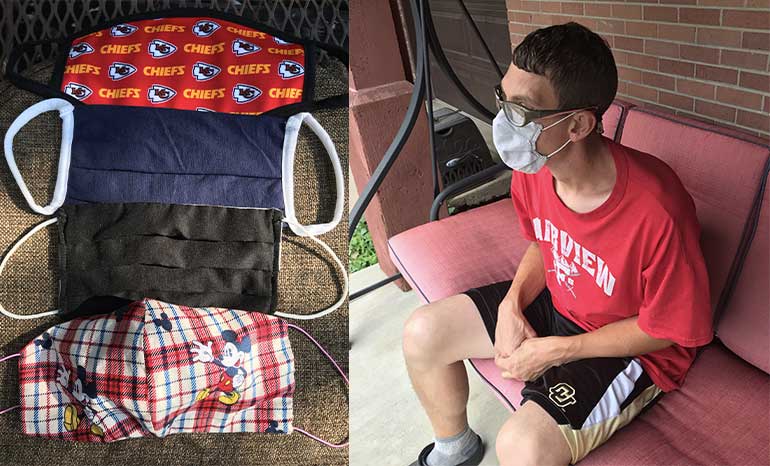By Jayne Dixon Weber
Video by Dr. Rebecca Shaffer
Some level of anxiety is a common reaction to wearing a mask for the first time. For those with a history of other anxiety disorders, masks can trigger danger signals, such as a fight or flight response from heat or the feeling that you can’t get enough air. And when the danger is real — as with COVID-19 — it only makes the adjustment more challenging.
Now, according to the CDC, people with developmental or behavioral disorders are not at any higher risk than the general population for contracting COVID-19 — unless (like the general population) — they have one or more other underlying medical conditions. However, they may have more difficulty assessing, understanding, and practicing recommended preventions, and of communicating symptoms should they become infected.
All of which means masks are important for all of us, especially those relying on others for their care. Here, our own Jayne Dixon Weber provides helpful tips on how to get your loved one with FXS comfortable wearing a mask, including insights into the issue within her own family.
But first, a short video from Dr. Rebecca Shaffer, director of psychological services for Cincinnati Children’s Fragile X Treatment and Research Center, entitled “Helping Individuals With Fragile X Syndrome Wear a Mask.”
The New Normal?
I have a feeling that masks are going to be a part of our lives for a long time.
“Do I have to wear a mask?” You’ve probably heard this question a lot lately, and as our new normal becomes simply normal, you’ll likely soon be replacing, “Get your mask” with “Got your mask?” And then the checklist you use before leaving your house will become:

As far as the current mask requirements, they differ by location. You can start here — State, Territorial, Local and Tribal Health Department Search — or search for your state, county, or city name plus mask requirements, i.e., minnesota mask requirements.
Even if masks aren’t required, many recommend it, especially if you can’t maintain a six foot distance from other people, like in a grocery store. There are some locations that require a mask, but have exemptions for those under the age of two or are unable to wear a mask due to a medical condition. (Note: This article refers to cloth masks that are not considered medical/surgical grade. If you have any concerns about your child wearing a mask, please talk to your child’s doctor.)
Also see (CDC): Use of Cloth Face Coverings to Help Slow the Spread of COVID-19
How Do I Help My Child Choose a Mask?
It might mean you have to buy (or make) a few to find out which one is going to work the best.
For my son, we found the fabric part of a mask that he liked, but he did not like the part that went around the ears — it was too thick. So, we took the skinny elastic off the disposable paper masks and sewed them on the fabric that he liked — it was perfect. We did that to a couple of masks so we would have extras. I found that I preferred the skinny elastic too.
One caution about the use of bandannas or face shields: They might not be accepted in the locations you visit.
Also: Be sure to wash your masks every day that you use them.
Tips for helping your child choose the right mask
- Show them a photo or videos of people wearing masks — they will not be hard to find.
- Show them different shapes of masks — seam down the middle, flat, pleated.

- Let them try out different fabrics, even some cotton fabrics are softer than others — they might even like t-shirt material.
- Let them try out different sizes of fabrics — larger fabrics means shorter ties around the ears.
- Look at different ear wraps or ties for around the head — thick or thin elastic, hair ties, shoelaces — to see which ones they might like the best.
- See if they want a mask they can decorate? Or show their support for sports teams, super-heroes, or animals? Or maybe they want a certain color? Anything it takes to get them to wear a mask and to help them feel like it is their own special mask. See our coloring page download if you or your children want to work on your own designs!

Where Can You Find a Mask?
1. You can make your own
There are videos on how to do that, both sew and no-sew kinds.
Search for face mask patterns, and add keywords depending on what you’re looking for: fitted, pleated, easy, with ties, with filter pockets, without pleats, etc. Here’s a few we found (please keep in mind that we did not test these first):
- Sew and no-sew options and tutorials from the CDC.
- Joann’s has a collection of mask projects and videos that can be filtered by skill level, and includes clever ideas like adding a reflective strip, making a mask you already have more comfortable, tie-dye masks, masks for teachers, and even mask storage and hamper projects.
- How to make an easy pattern & sewing tutorial, from Mia DIY on YouTube.
- No-fog face mask: simple hack that really works, from You Make it Simple. (Also available as a video on YouTube.)
2. You can buy them online
There are now hundreds of sites.
To get you started, here’s a few lists we found that looked interesting:
- For buying online plus being handmade, we found a lot of face mask options on Etsy.
- A list of 38 places to buy cloth face masks online from House Beautiful.
- A list of 25 face mask styles we love that you can buy or make from Cnet.
3. Maybe a friend or grandparent will make one for your child?
Try sharing one of the links for face mask patterns with someone you know that likes to sew?
How Can I Get My Child Used to Wearing a Mask?
Proceed at their own pace. Here’s one way to approach it, but modify it to what works for your child and family. Use visuals if that will help.
1. Start by holding the mask up to your face, which you may have already been doing when you were picking out the fabric.
2. Have everyone in the family hold their masks up to their face.
3. Have them put the mask on over their ears. Have them say, “Hi, mom.” Take it off.
4. Have them put the mask on and go out in your backyard and come right back in. Take it off.
5. Have them put the mask on and watch your favorite TV show. Take it off.
6. Have them put the mask on and go out in the front yard and sit on the front porch/steps for a while. Take it off.
7. Have them put the mask on and go for a short walk in the neighborhood with your family. Take it off.
8. When you’re ready, take a family photo — with your masks on — and send it to me:
Personally, I actually have a harder time wearing a mask than my son does, so I limit how often and where I go. I go for a walk every morning and while I always have a mask with me, I go early in the morning and dodge around the few people I see to keep that six foot distance, though I try for closer to 20 to 30 feet.
Dodging people means I get extra steps in because I am going back and forth across the street. I am sure people are rolling their eyes at me, but with sunglasses and a mask on, I like to think I am traveling incognito. It is like my own little game. Hey, these days, we do whatever it takes to entertain ourselves.
We are not sure how long this COVID-19 situation is going to last, so I encourage you to make the most of it. Do fun things around the house, start some new rituals, learn something new — and even if you are busier now than you have ever been — be sure to take breaks to just be “present” for a little time each day. With your masks on, of course.
Be sure to check out more COVID-19 resources below.
—Jayne
jayne@fragilex.org
about

Jayne Dixon Weber
Jayne served as the NFXF director of community education (and other positions over the years) from 2007 to 2023. She has two adult children, a son with Fragile X syndrome and a daughter. Jayne is the author of Transitioning ‘Special’ Children into Elementary School, co-author of Fragile X Fred, and editor of Children with Fragile X Syndrome: A Parents’ Guide. Jayne likes to read, enjoys photography, and goes for a walk every day.
About

Rebecca Shaffer, PsyD, HSPP
Dr. Shaffer is the director of psychological services for Cincinnati Children’s Fragile X Treatment and Research Center. She performs evaluations necessary for clinical research and provides psychological assessment and behavioral treatment for individuals with Fragile X syndrome, autism spectrum disorders, and Angelman Syndrome.
MORE COVID-19 RESOURCES
Let the Awareness Continue!
It looks like in many places we're back to wearing masks, or will be soon. Our family has pulled out all our favorite masks and getting used to them all over again.
COVID-19 Check-In: Month 15 — Ready for Re-Entry?
Jayne offers advice to Fragile X families in transitioning back after post-COVID-lockdowns, from school, to housing, to work, and more.
COVID-19 Vaccines and Fragile X and Dr. Erickson Answers Your Medication Questions
Two important videos from Dr. Craig Erickson who discusses COVID-19 vaccines for individuals living with Fragile X premutations and full mutations, plus a second video on medications and Fragile X.
Is the COVID-19 Vaccine Safe for Individuals with Fragile X?
Dr. Craig Erickson, director of the Cincinnati Fragile X Research and Treatment Center at the Cincinnati Children's Hospital, received his first dose of the COVID-19 vaccine tells us why it’s safe.

